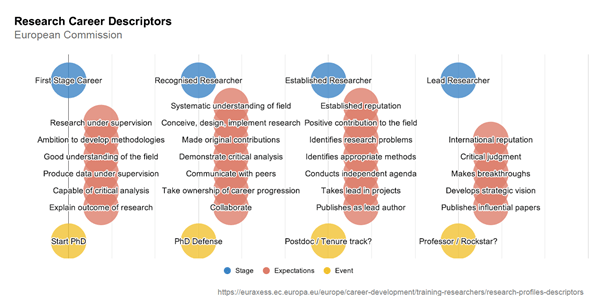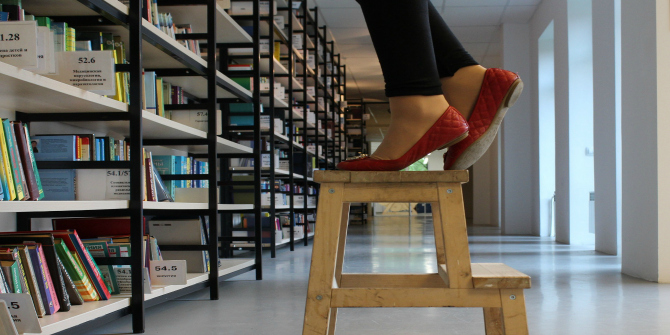Research systems often envisage academic careers as linear and sequential. However, Nicolas Robinson-Garcia, Rodrigo Costas, Cassidy R. Sugimoto, Vincent Larivière and Gabriela F. Nane argue that, not only do career stages in science tend to be more diverse than are usually recognised, but they also change profile over the course of a career. By mischaracterising academic careers in this way, the authors warn research systems risk reinforcing a limited interpretation of science.
Researchers collaborate by specialising in specific tasks. However, research evaluation systems tend to reward some research profiles over others. From the vantage point of research bureaucracy, research careers are envisioned as homogeneous pathways in which individuals take a series of steps to advance. In each step, researchers must comply with certain criteria, usually so embedded into expectations of scientists that many countries and supranational agencies explicitly outline exactly what is expected of individuals at each stage. The rationale behind this is to ensure that career paths align with academic positions. However, in a recent study we observed that not only do scientists exhibit different profiles based on their task specialisation, but that these profiles change over time, potentially impacting their career prospects.
Figure1 summarises this perspective on research careers. The full description of research profiles reveals how a one-size-fits all career trajectory is designed, where words such as excellence and leadership are reiterated and are even interchangeable at each stage. But one might question to what extent those expectations match reality. Is there such a link between career stages and researcher profiles? What happens when researchers deviate from expected roles?
Figure 1. Graphical representation of the career stages designed by the European Commission along with the expectations at each state, and an attempt at aligning them in a timeline.
To test these questions, we designed a model to predict the probability of scientists contributing in specific ways over their career. Based on a machine learning algorithm and using the contribution statements from scientific publications (all data openly accessible),we identified several researcher archetypes across career stages. We distinguished between four career stages and compared differences between these archetypes based on their career length, productivity, citation impact and gender.
Distribution of labour and archetypes
We already know that scientists tend to specialise during their career to maximize efforts when collaborating. Authors’ contributions are also commonly associated with their position in author order, middle positions signal those conducting more technical and specialised tasks, with first and last reserved to those leading the work. If the idealised career path resembles reality, one would expect junior scientists to be earning their stripes first in middle positions, contributing with technical expertise, and later moving towards leading roles. But, this is not what we observe, an increasing number of middle authors never reach leading positions. Is their middle position related to task specialisation?
We predicted the probability of contributions of over 200,000 researchers to each of their published papers during their publication history. Figure 2 shows the distribution of our predicted probabilities distinguished by career stage.
Figure 2. Distribution of predicted probabilities of contributions for the complete history of researchers.
These distributions already show that some contributions are more aligned with career stages than others, but the distinction is not as clear as one might imagine. Still, we are not able to discern if individuals consistently carry on the same contributions when collaborating.
By applying Robust Archetypal Analysis, – a technique that identifies archetypes which accentuates specific features of individuals’ population – we found consistent similarities between archetypes across stages, with two archetypes at the junior stage (specialised and supporting), three at the early- and mid-career stages (leader, specialised and supporting), and two at the late-career stage (leader and supporting). Leaders are characterised by high probabilities of writing the paper and conceiving and designing the study. Specialists are researchers who are in charge of performing experiments, but who may also contribute to the writing, conception of the study and analysis of data. Finally, supporting authors make more marginal contributions to papers.
Career trajectories, productivity, impact and gender
So, scientists do specialize on specific tasks, but do they exhibit the same profile throughout their career? Are there differences in their performance? Do we observe differences by gender on the profile of scientists? We assigned researchers to the archetype they most resembled at each stage and found that scientists do not exhibit a singly archetype, but move between archetypes during their career (Figure 3). Furthermore, a researcher’s profile seems to influence their possibility of making it to the next stage. A larger share of leaders makes it to the next stage, followed by specialists and last, supporting. Leader profiles seem to be more versatile, that is, they more easily shift to any of the other two profiles.
 Figure 3. Trajectories of scientists analysed by archetype. Blue shows the specialised profile; green, supporting; and red, leader.
Figure 3. Trajectories of scientists analysed by archetype. Blue shows the specialised profile; green, supporting; and red, leader.
Leaders and supporters are more productive and receive more citations than specialists. This means that evaluation based on productivity and citation metrics may be undermining specific and indeed valuable researcher profiles. Most worryingly, there are gender differences at the early-career stage. That is, most men at this stage show either a specialised or leader profile, while for women there is a strong bias towards the former. At this critical stage, this could be affecting women’s career prospects in a definite way, as their performance is hindered by the type of tasks they perform.
Revising assumptions and looking forward
This study is part of the wider ‘Unveiling the Ecosystem of Science’ project, which aims to systematically analyse the diversity of profiles in science, with the hope of devising methodological tools that can improve current evaluation systems. With this specific study we also look into the potential of overcoming the well-known limitations of authorship by going beyond equal attribution of credit among authors. For instance, we observe that neither seniority nor archetype are always the ruling criteria in author position (Figure.4).
 Figure 4. Share of scientists by career stage and archetype based on their author order in publications.
Figure 4. Share of scientists by career stage and archetype based on their author order in publications.
With this study we hope to develop the conversation around diversity in science. The ultimate aim being to improve our understanding of this diversity, and design evaluation tools that can contribute to efforts to build a more hospitable work environment for all researchers. Narrow definitions of excellence and poorly designed research careers, not only work against the progress of science, but affect attitudes towards success and failure, and as the philosopher Michael Sandel warns only “generate(s) hubris and anxiety among the winners and humiliation and resentment among the losers”.
Note: This article gives the views of the authors, and not the position of the Impact of Social Science blog, nor of the London School of Economics. Please review our Comments Policy if you have any concerns on posting a comment below.
Image Credit: Zane Lee via Unsplash.









